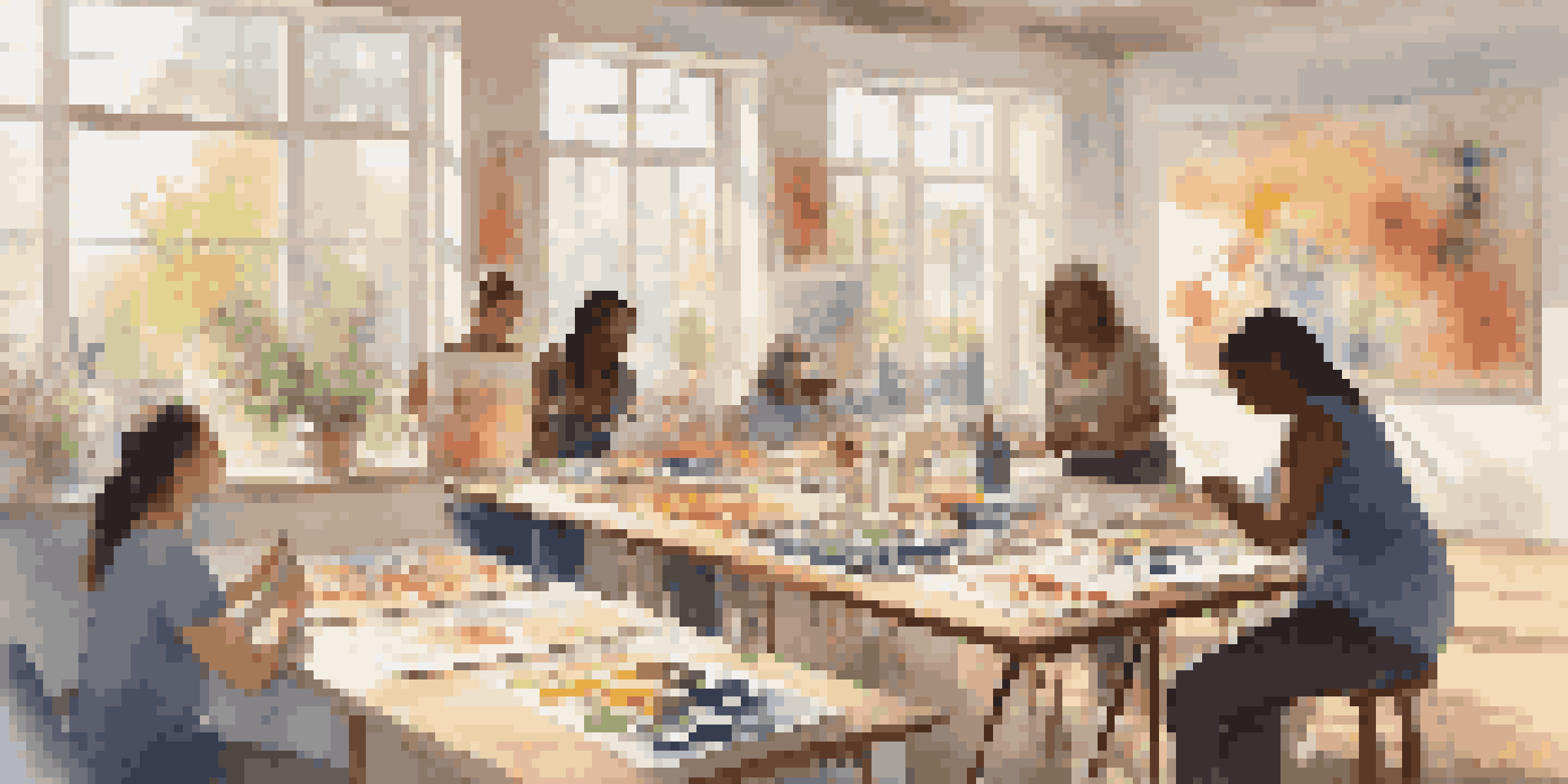Art and Emotion Regulation: The Neurobiology of Creativity

Understanding Emotion Regulation and Its Importance
Emotion regulation refers to our ability to manage and respond to emotional experiences effectively. It's a crucial skill that helps us navigate life's ups and downs, influencing our overall mental health and well-being. Without proper regulation, emotions can overwhelm us, leading to anxiety, depression, or even erratic behavior.
Art is the most beautiful of all lies; it is a wonderful expression of the emotions we often cannot articulate.
The process involves both conscious and unconscious strategies, allowing individuals to modify their emotional responses. For example, someone might use distraction techniques to cope with sadness or engage in mindfulness practices to ground themselves during stress. These strategies not only help alleviate immediate emotional distress but also enhance resilience over time.
Understanding how we regulate emotions can lead to better coping mechanisms and improved relationships. When we can articulate our feelings and manage them effectively, we create a healthier emotional landscape, paving the way for personal growth and emotional intelligence.
The Role of Art in Emotional Expression
Art serves as a powerful medium for expressing emotions that might be difficult to articulate verbally. Whether it's painting, music, or dance, creative outlets allow individuals to channel their feelings into something tangible. This form of expression can be liberating, offering a safe space to explore complex emotions.

For instance, a person experiencing grief might find solace in creating a piece of art that reflects their loss. Instead of bottling up their feelings, they can transform their pain into something beautiful, providing both catharsis and understanding. This process not only aids in emotional release but also fosters connection with others who may resonate with similar experiences.
Emotion Regulation Enhances Well-Being
Effectively managing emotions is crucial for mental health and fosters personal growth.
Moreover, engaging with art—whether by creating or consuming it—can enhance emotional awareness. By interpreting visual cues or musical tones, individuals can gain insights into their own feelings, promoting a deeper understanding of themselves and their emotional responses.
Neuroscience of Creativity and Emotion Regulation
The relationship between creativity and emotion regulation is deeply rooted in neuroscience. Studies suggest that engaging in creative activities activates specific regions of the brain associated with emotional processing, such as the prefrontal cortex and limbic system. These areas are crucial for self-expression and emotional regulation.
Creativity takes courage.
Creativity can stimulate the release of neurotransmitters like dopamine, which plays a role in pleasure and reward. This biochemical response not only enhances mood but also encourages individuals to explore their emotions more freely. When we create, we engage in a process that can transform negative feelings into positive outcomes, fostering emotional balance.
Additionally, neuroplasticity—the brain's ability to reorganize itself—plays a significant role in this dynamic. Regular engagement in creative practices can lead to lasting changes in how we process emotions, equipping us with better tools for regulation and resilience in the face of life's challenges.
Art Therapy as a Tool for Emotional Healing
Art therapy is a structured approach that utilizes creative processes to help individuals explore and express their emotions. It combines traditional therapeutic practices with artistic expression, creating a unique environment for healing. During sessions, clients engage in various artistic activities while guided by a trained therapist, focusing on self-exploration and personal growth.
This therapeutic modality can be particularly beneficial for those dealing with trauma, anxiety, or depression. By engaging in art, clients can externalize their feelings, making it easier to confront and process difficult emotions. As they create, they often uncover insights that might remain hidden in traditional talk therapy.
Art as a Medium for Emotional Healing
Creative expression through art provides a safe outlet for exploring and processing complex emotions.
Moreover, art therapy fosters a sense of empowerment and agency. Clients not only gain a voice through their creations but also build confidence as they witness their ability to articulate complex emotions. This empowerment can lead to improved emotional regulation and overall well-being.
How Different Art Forms Impact Emotions
Different art forms can evoke and regulate emotions in unique ways. For example, music has a profound impact on our feelings—think about how a sad song can bring tears to your eyes while an upbeat tune makes you want to dance. Each genre and rhythm can tap into specific emotional states, influencing how we feel and respond to our environment.
Visual arts, such as painting or sculpture, offer a different sensory experience that engages our visual and tactile senses. The colors, shapes, and textures can evoke emotions ranging from joy to melancholy, allowing for a multi-dimensional exploration of feelings. A vibrant painting may uplift our spirits, while a dark, moody piece might resonate with our inner struggles.
Dance, on the other hand, combines physical movement with emotional expression. It's a way to communicate feelings through the body, often transcending language barriers. Whether it's a graceful ballet or an energetic hip-hop performance, dance can serve as an outlet for emotional release and connection with others.
The Benefits of Engaging in Creative Activities
Engaging in creative activities offers a wealth of benefits beyond emotional expression. These activities can enhance cognitive functions, improve problem-solving skills, and boost self-esteem. When we create, we engage different parts of our brain, fostering neuroplasticity and encouraging new ways of thinking.
Moreover, creativity can serve as a stress reliever. When we immerse ourselves in a creative task, we often enter a state of flow—a mental state where we lose track of time and become fully absorbed in the activity at hand. This state not only feels rewarding but also provides a break from daily stressors, contributing to mental clarity and relaxation.
Creativity Boosts Emotional Resilience
Engaging in creative activities not only relieves stress but also improves emotional regulation and self-awareness.
Additionally, creativity encourages social interaction and connection. Whether through collaborative art projects or sharing our work with others, these experiences foster community and support. Building relationships through creativity can enhance our emotional well-being, reminding us that we are not alone in our experiences.
Cultivating Creativity for Better Emotional Regulation
Cultivating creativity in everyday life can significantly improve our ability to regulate emotions. Simple practices, such as journaling, doodling, or playing an instrument, can help us tap into our creative potential. These activities not only provide an outlet for emotional expression but also allow us to explore our thoughts and feelings in a non-judgmental way.
Setting aside time for creative pursuits can integrate mindfulness into our lives. As we focus on the creative process, we become more present, allowing us to observe our emotions without becoming overwhelmed. This awareness can lead to better emotional regulation, as we develop a deeper understanding of our feelings and triggers.

Embracing creativity doesn't require artistic talent; it's about exploring what resonates with us personally. Whether it's cooking, gardening, or crafting, finding joy in the creative process can empower us to manage our emotions more effectively, fostering a sense of fulfillment and resilience.